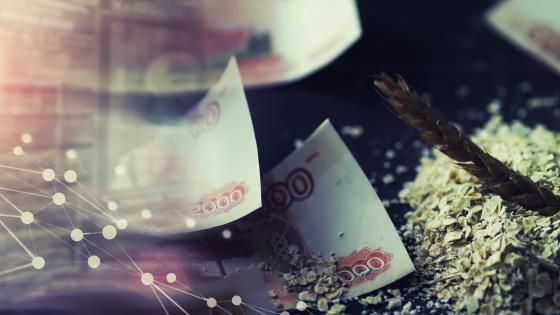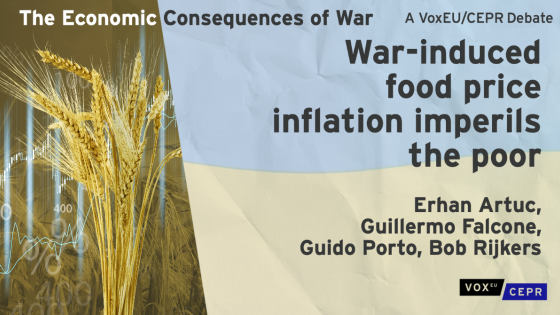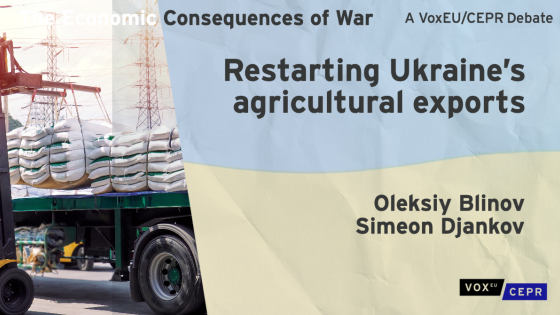Food insecurity was top-of-mind throughout 2022 as the fallout from the conflict in Ukraine on crop production and shipments materialised (Deininger et al. 2023, Glauber 2023, Abay et al. 2023). Diplomacy helped: the agreement of the Black Sea Grain Initiative restarted exports from Ukraine (Timmer 2023). International organisations heightened surveillance of export controls on food and called for governmental restraint (World Bank et al. 2022, FAO et al. 2022). Political appeals notwithstanding, the Global Trade Alert recorded the implementation of 180 new export curbs in agricultural products last year, but 233 steps were taken to liberalise imports.
What about 2023? There is no end in sight to the armed conflict in Ukraine. What is at stake if the Black Sea Grain Initiative is not renewed in mid-March? What if Moscow weaponised wheat exports during 2023? Using reputable, December 2022 forecasts for wheat harvests during the 2022/23 season, in this column we present evidence on the extent of Russia’s leverage of the world wheat market and its incentives to weaponise wheat.
Ends and means
The Russian government has three means to weaponise wheat exports.
- For more than a decade Russia has applied export bans, export taxes and export quotas to its wheat shipments. These policies are part of Russia’s approach to agricultural trade management. Last year alone, Russia changed export policies on agricultural goods 99 times, according to the Global Trade Alert database.
- Russia could refuse to renew the temporary Black Sea agreement. As of this writing, Russia is pushing for a quid pro quo for doing so. When Russia signalled it might withdraw from the deal in early November 2022, wheat futures prices at the Chicago Board of Trade jumped 5.8%. Once the deal was renewed, futures prices fell only 2%.
- Russia has intervened in the wheat market through the Kremlin-owned trading company UGC since 2009. To withhold grain from the world market, UGC purchases domestically grown wheat for its stockpile. Reuters reports that UGC has offered the Kremlin to buy 3 million tonnes of wheat by 2024. In July 2022, the Russian Ministry of Agriculture announced that it had purchased 1 million tonnes of wheat.
Identifying possible motives for weaponisation isn’t hard either. These include:
- Russia needs to finance the conflict in Ukraine. Estimates of Russia’s military expenses vary but they are all in the range of tens of billions of US dollars. Taxes collected on the exports of billions of dollars of wheat help finance the invasion of Ukraine at a time when other revenues are at risk.
- The mere threat of blocking Ukraine’s exports reduces the incomes of Ukrainian farmers and discourages the incentive to plant for future seasons, with knock-on effects for Kyiv’s government revenues and, therefore, its capacity to finance its military campaign.
Big changes in wheat production forecast for 2023
The extent to which Russian weaponisation of wheat disrupts world markets and food security will depend on factors beyond Russia’s control, including the size of the global wheat harvest. The fact that wheat prices did not spiral out of control last year may be more down to good luck than good policy. Glauber et al. (2022) point out that Argentina and Brazil were able to expand their wheat exports by 6.6 million tonnes during the first half of 2022. Luck may be running out according to the well-regarded forecasts by the U.S. Department of Agriculture (2022a, 2022b). In its December 2022 update, the USDA foresees:
- stagnant global wheat production (from 779.3 million tonnes in 2021/2 to 780.6 million tonnes in 2022/3);
- declining wheat production among major growers including Ukraine (by 12.5 million tonnes), Argentina (9.7 million tonnes), and the EU (3.9 million tonnes);
- rising wheat production in Russia (by 14.8 million tonnes), Canada (by 11.1 million tonnes), and Kazakhstan (by 2.2 million tonnes) as well as in Brazil, China, Iran, Turkey, and the UK (by between 1 million and 2 million tonnes each).
To put these forecasts in context, recall that prior to the conflict (during 2020/21) Russia accounted for 19.2% of world wheat exports. Our simulations predict that, in the absence of any weaponisation of wheat trade, Russia would supply 22.8% of world wheat exports this year simulations (Evenett and Muendler 2023). Similarly, the U.S. Department of Agriculture (2022b) forecasts a 20.4% share. In contrast, the nations sanctioning Russia are expected to see their net production rise by only 0.9% of the world total. If Russia keeps its additional wheat production off world markets in 2023, Western wheat cannot easily replace it.
Simulating Russian leverage over the world wheat market
To make matters concrete, we backed out from the USDA’s forecasts the implied changes in yield (productivity) for each main wheat exporter and simulated what leverage Russia has over the global wheat market in the 2022/3 season (Evenett and Muendler 2023). We considered scenarios where Russia blocks different percentages of Ukrainian wheat exports and where Russia decides to cut its own wheat exports by up to half. Our simulations show how much leverage the Russian Federation could have on world wheat prices and what threat Moscow poses to food security, principally in developing countries.
If the Kremlin withholds a quarter of Russia’s wheat exports, for example, it takes 10.8 million tonnes of wheat off the world market. Preventing all Ukrainian wheat shipments in the Black Sea, in contrast, only leads to small increases in Russian exports while larger shipments from other suppliers result in little change in total wheat supplies to the world market (Evenett and Muendler 2023). Russia’s diplomatic niceties with respect to Black Sea transportation should, therefore, not be mistaken for good intentions towards the wheat market overall.
We also studied potential export tax regimes to assess the Kremlin’s incentives to manipulate world wheat markets. For instance, a Russian export tax regime that cuts one-quarter of Russia’s wheat exports generates for the Kremlin tax revenues equivalent to almost a third of the Russian wheat industry’s value added. Naturally, the economy-wide cost of the resulting market distortions is large for Russia, and amounts to more than one-third of wheat value added. But in a war economy this loss may matter little in comparison to the Kremlin’s prospective use of any additional export tax revenues.
Here are key policy-relevant findings from our simulations (Evenett and Muendler 2023):
- Given wheat production forecasts, no matter how much Ukrainian wheat Russia allows to pass through the Black Sea, 2.5 million tonnes more wheat will be on world markets than before the conflict began. This limits the resulting wheat price hikes during 2023. Even a near-complete Black Sea transport ban on Ukrainian wheat would raise the median importer’s wheat price by 4.2%. But sourcing patterns are such that wheat prices in the Philippines, Indonesia and Tunisia, for instance, would rise by more than 27%.
- If Russia putatively raises export taxes high enough to cut its wheat exports by one-quarter, and farmers across the two hemispheres respond to the intervention within the year, then world wheat imports will drop by about 2 million tonnes in total because competing exporters can only partially replace the lost Russian wheat exports. Under this scenario the median importing nation pays 5.2% more for wheat. The Kremlin’s export tax collection amounts to 29.7% of the Russian wheat industry’s value added in the absence of export restrictions.
- If Russia goes further and raises export taxes so as to cut its wheat exports in half, then total wheat imports fall by 3.4 million tonnes and the median importer pays 9 percent more for wheat than before the conflict. Bangladesh and Nigeria now face above-median wheat price increases of around 14% and 11%, while the Kremlin collects 55.6% of the Russian wheat industry’s value added in tax revenues.
More comprehensive monitoring needed
As Moscow scrambles to finance its military campaign in Ukraine, the temptation to weaponise wheat exports will grow. A larger harvest next year strengthens Russia’s leverage over world wheat markets. Russia’s influence on world wheat prices will be greater if it hikes export taxes as compared to refusing to extend the Black Sea Grain Initiative. Several developing countries with large populations are at risk should Moscow weaponise exports – and contingent financing to help could be lined up now. Russian wheat growers will also be victims of weaponisation, diminishing their incentive to plant in future seasons.
Foreign governments and international organisations should monitor not only Russian export tax changes but also Moscow’s state purchases of wheat from Russian farmers. Conceivably, Russia could stockpile plenty of wheat and then engage in ‘wheat diplomacy’ with countries that are desperate to feed their populations. The Black Sea deal is important but, as far as global food insecurity is concerned, it isn’t the only game in town.
References
Abay, K, C Breisinger, J Glauber, S Kurdi, D Laborde, and L Siddig (2023), “The Russia-Ukraine war: Implications for global and regional food security and potential policy responses”, Global Food Security, March.
Deininger, K, D Ayalew Ali, N Kassul, A Shelestov, G Lemonie, and H Yalimova (2023), “Quantifying war-induced crop losses in Ukraine in near real time to strengthen local and global food security”, Food Policy, February.
Evenett, S J and M-A Muendler (2023), “Weaponizing Wheat Moscow’s Menace to Food Security in 2023”, cBrief 3, University of San Diego Globalization and Prosperity Lab and the St. Gallen Endowment for Prosperity through Trade, 9 January.
Food and Agriculture Organization, World Bank, IMF, World Food Programme and WTO (2022), “Second Joint Statement by the Heads of FAO, IMF, WB, and WTO on the Global Food Security and Nutrition Crisis”, 21 September.
Glauber, J (2023), “Ukraine one year later: Impacts on global food security”, IFPRI blog, 23 February.
Glauber, J, D Laborde, V Pineiro and A Tejeda (2022), “Can agricultural exports from Southern Cone countries make up for global supply disruptions arising from the Russia-Ukraine war?”, IFPRI Blog, 14 November.
Timmer, P (2023), “Despite the odds, multilateral cooperation has helped secure global food security”, East Asia Forum, 5 March.
U.S. Department of Agriculture (2022a), “World Agricultural Production”, World Agricultural Outlook Board, WAP 12-22, December.
U.S. Department of Agriculture (2022b), “World Agricultural Supply and Demand Estimates”, World Agricultural Outlook Board, WASDE 631, December.
World Bank, IMF, World Food Programme and WTO (2022), “Joint Statement of the World Bank Group, IMF, WFP, and WTO Call for Urgent Coordinated Action on Food Security”, 13 April.



